Filling the gap, evolutionarily conserved Omp85 in plastids of chromalveolates
- PMID: 20042599
- PMCID: PMC2825478
- DOI: 10.1074/jbc.M109.074807
Filling the gap, evolutionarily conserved Omp85 in plastids of chromalveolates
Abstract
Chromalveolates are a diverse group of protists that include many ecologically and medically relevant organisms such as diatoms and apicomplexan parasites. They possess plastids generally surrounded by four membranes, which evolved by engulfment of a red alga. Today, most plastid proteins must be imported, but many aspects of protein import into complex plastids are still cryptic. In particular, how proteins cross the third outermost membrane has remained unexplained. We identified a protein in the third outermost membrane of the diatom Phaeodactylum tricornutum with properties comparable to those of the Omp85 family. We demonstrate that the targeting route of P. tricornutum Omp85 parallels that of the translocation channel of the outer envelope membrane of chloroplasts, Toc75. In addition, the electrophysiological properties are similar to those of the Omp85 proteins involved in protein translocation. This supports the hypothesis that P. tricornutum Omp85 is involved in precursor protein translocation, which would close a gap in the fundamental understanding of the evolutionary origin and function of protein import in secondary plastids.
Figures
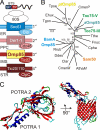
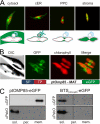
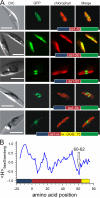
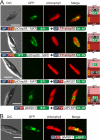

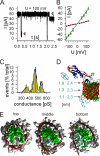
Similar articles
-
The invariant phenylalanine of precursor proteins discloses the importance of Omp85 for protein translocation into cyanelles.BMC Evol Biol. 2007 Nov 28;7:236. doi: 10.1186/1471-2148-7-236. BMC Evol Biol. 2007. PMID: 18045484 Free PMC article.
-
Identification and characterization of a new conserved motif within the presequence of proteins targeted into complex diatom plastids.Plant J. 2005 Jan;41(2):175-83. doi: 10.1111/j.1365-313X.2004.02294.x. Plant J. 2005. PMID: 15634195
-
New mechanistic insights into pre-protein transport across the second outermost plastid membrane of diatoms.Mol Microbiol. 2010 May;76(3):793-801. doi: 10.1111/j.1365-2958.2010.07142.x. Epub 2010 Mar 25. Mol Microbiol. 2010. PMID: 20345650
-
Evolution of the general protein import pathway of plastids (review).Mol Membr Biol. 2005 Jan-Apr;22(1-2):73-86. doi: 10.1080/09687860500041916. Mol Membr Biol. 2005. PMID: 16092526 Review.
-
Protein import into cyanelles and complex chloroplasts.Plant Mol Biol. 1998 Sep;38(1-2):247-63. Plant Mol Biol. 1998. PMID: 9738970 Review.
Cited by
-
Directing traffic: Chaperone-mediated protein transport in malaria parasites.Cell Microbiol. 2020 Jul;22(7):e13215. doi: 10.1111/cmi.13215. Epub 2020 May 26. Cell Microbiol. 2020. PMID: 32388921 Free PMC article. Review.
-
Chloroplast Omp85 proteins change orientation during evolution.Proc Natl Acad Sci U S A. 2011 Aug 16;108(33):13841-6. doi: 10.1073/pnas.1108626108. Epub 2011 Aug 8. Proc Natl Acad Sci U S A. 2011. PMID: 21825140 Free PMC article.
-
Genomic perspectives on the birth and spread of plastids.Proc Natl Acad Sci U S A. 2015 Aug 18;112(33):10147-53. doi: 10.1073/pnas.1421374112. Epub 2015 Apr 20. Proc Natl Acad Sci U S A. 2015. PMID: 25902528 Free PMC article.
-
Major Changes in Plastid Protein Import and the Origin of the Chloroplastida.iScience. 2020 Mar 27;23(3):100896. doi: 10.1016/j.isci.2020.100896. Epub 2020 Feb 8. iScience. 2020. PMID: 32088393 Free PMC article.
-
ERAD components in organisms with complex red plastids suggest recruitment of a preexisting protein transport pathway for the periplastid membrane.Genome Biol Evol. 2011;3:140-50. doi: 10.1093/gbe/evq074. Epub 2010 Nov 15. Genome Biol Evol. 2011. PMID: 21081314 Free PMC article.
References
-
- Field C. B., Behrenfeld M. J., Randerson J. T., Falkowski P. (1998) Science 281, 237–240 - PubMed
-
- Gould S. B., Waller R. F., McFadden G. I. (2008) Annu. Rev. Plant Biol. 59, 491–517 - PubMed
-
- Bolte K., Bullmann L., Hempel F., Bozarth A., Zauner S., Maier U. G. (2009) J. Eukaryot. Microbiol. 56, 9–15 - PubMed
-
- Hempel F., Bullmann L., Lau J., Zauner S., Maier U. G. (2009) Mol. Biol. Evol. 26, 1781–1790 - PubMed
Publication types
MeSH terms
Substances
LinkOut - more resources
Full Text Sources
Miscellaneous

